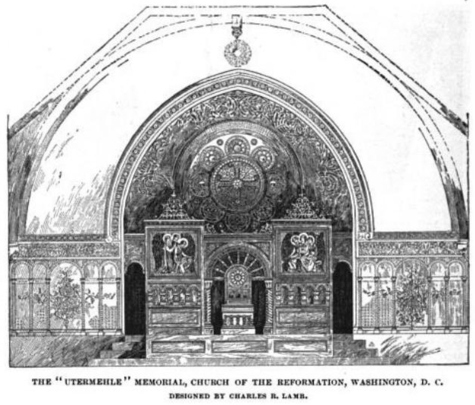 In looking for picture of the subject of last week’s column, I saw that there was a church next door, one that had also been knocked down to make way for the Adams Library of Congress building. A quick search of the records turned up the information that this was the predecessor to the Lutheran Church of the Reformation, well-known to Hill families for housing not only the Capitol Hill Cooperative Playschool, but also River Park nursery school.
In looking for picture of the subject of last week’s column, I saw that there was a church next door, one that had also been knocked down to make way for the Adams Library of Congress building. A quick search of the records turned up the information that this was the predecessor to the Lutheran Church of the Reformation, well-known to Hill families for housing not only the Capitol Hill Cooperative Playschool, but also River Park nursery school.
The first Lutheran Church in DC was St. Paul’s Church, founded in 1843. They built their church on the corner of 11th and H NW, and found themselves expanding rapidly as the city expanded. In the post-Civil War boom, it became clear that churches were needed all across the city, and so in 1869, members of St. Pauls who lived in Southeast DC gathered together and formed a new church, giving themselves the name Church of the Reformation. The first 10 years were tough, with them meeting in an old school as well as an old army hospital. Finally, in 1879, they found themselves with the wherewithal to build their own edifice. They chose a spot on B Street SE, two blocks east of the Capitol.
By October 1881, the church was completed to the point where the congregation could meet in the basement meeting room; the actual auditorium was left uncompleted until they could raise the money to finish the work.
In the late 1890s, the original, severe lines of the church interior were considered unacceptable, and the noted architect, Charles Rollinson Lamb was hired to make the interior appropriate to what a flourishing church should have. The church closed entirely for two months for the work to proceed, and the Washington Post wrote about the results on November 2, 1889:
The frescoing has been done by New York artists, and the colors and designs are in harmony. The new pipe organ, which cost $2,800, has been accepted as a very fine instrument. The carpets, hangings, and windows are all new and blend in keeping to the other improvements.
Frank Leslie’s Popular Monthly published an etching of the interior, writing that “all its ugliness [has] disappeared and an imposing interior [has] resulted[.]”
One of the members of the congregation who worshiped in the new interior was a young man who lived a few blocks down Pennsylvania Avenue from the church, on Seward Square: J. Edgar Hoover. His mother, Annie, was a staunch Lutheran, and so this was the obvious church for her son to attend. He at first was a willing churchgoer, singing in the choir as well as winning ribbons for attendance, but he soon found himself drawn to the preaching of a local Presbyterian minister, and so forsake his maternal church.
Even with this loss. the church continued to flourish but, unfortunately, so did their closest neighbor, the Library of Congress. In 1928, with the original LOC building becoming too small, it was suggested that the land to the east of it should be bought. Money was appropriated in 1930, and the owners of the buildings on the site, including the Church of the Reformation, were told that they had until the end of October, 1931 to vacate. Unfortunately, the church members and the government were unable to come to an agreement about the valuation of the land, and so a trial was convened to come to find out whether the land was worth 85,000 dollars, as the government said, or 112-117,000 as the church members insisted. In the end, the jurors declared the value to be 103,000 and, with this money, the Church of the Reformation was able to begin work on their edifice on East Capitol Street, across from the Folger Library. It took until May, 1933 to find the appropriate land, but fortunately they have been able to remain there until today.

